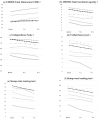Longitudinal Evaluation of the Effect of Tricyclic Antidepressants and Neuroleptics on the Course of Huntington's Disease-Data from a Real World Cohort
- PMID: 33805940
- PMCID: PMC8064332
- DOI: 10.3390/brainsci11040413
Longitudinal Evaluation of the Effect of Tricyclic Antidepressants and Neuroleptics on the Course of Huntington's Disease-Data from a Real World Cohort
Abstract
Background: Reducing the progress of neurodegeneration is a key goal in Huntington´s disease (HD). A previously performed systematic screening for medications with neuroprotective features identified tricyclic antidepressants and neuroleptics as neuroprotective and mitochondrioprotective agents. Here, we analyzed the characteristics of disease manifestation, progression and potential beneficial effects in HD patients treated with afore-mentioned medications compared to un- and otherwise treated motor-manifest patients in a large real-world cohort over two years. Methods: We analyzed cross-sectional data of the largest cohort worldwide of motor-manifest HD patients using the ENROLL-HD database, including demographic, moleculargenetic, clinical-motoric, cognitive and functional data. Longitudinal data of up to two years were obtained to analyze potential effects on disease progression between groups with different medications used. Data were analyzed using repeated ANOVA-analyses while controlling for the co-variates age and CAG-repeat length. Results: We identified n = 7397 motor-manifest HD patients using no or different medication (HD-ctrl) and subgroups treated with clomipramine (n = 56), clozapine (n = 66), chlorpromazine (n = 17), doxepine (n = 34) and desi-, imi- or trimipramine (n = 19). Demographic parameters, disease onset and CAP-score did not differ. Total motor scores (TMS) at baseline were higher in patients treated with clozapine (p < 0.001), chlorpromazine and clomipramine (p < 0.05) compared to HD-ctrl with higher sub scores for bradykinesia (all p < 0.01) and dystonia in clozapine treated patients (p < 0.001). Functional and cognitive capacities were worse in medication groups in comparison to HD-ctrl at baseline (p < 0.001). Repeated measures analysis of variance documented no differences regarding motoric, functional and cognitive disease progressions between groups. Conclusions: We identified group differences, potentially caused by side effects or potential selection bias in terms of bradykinetic motoric symptoms, more dystonia and lower functional and cognitive performance in some treatment groups at baseline, which were not entirely explained because of underlying fundamental characteristics. Disease progression regarding clinical, functional and cognitive outcomes over two years was not affected by any of the treatment groups compared to HD-ctrl. Our data do not support our hypothesis of a potential neuroprotective effect of these drugs on disease progression.
Keywords: ENROLL-HD; Huntington’s disease; neuroleptics; neuroprotection; tricyclic antidepressants.
Conflict of interest statement
The authors declare no conflict relevant to the content of this manuscript.
Figures



Similar articles
-
Positive effect of immunomodulatory therapies on disease progression in Huntington's disease? Data from a real-world cohort.Ther Adv Neurol Disord. 2022 Jul 23;15:17562864221109750. doi: 10.1177/17562864221109750. eCollection 2022. Ther Adv Neurol Disord. 2022. PMID: 35899100 Free PMC article.
-
Another Perspective on Huntington's Disease: Disease Burden in Family Members and Pre-Manifest HD When Compared to Genotype-Negative Participants from ENROLL-HD.Brain Sci. 2021 Dec 8;11(12):1621. doi: 10.3390/brainsci11121621. Brain Sci. 2021. PMID: 34942923 Free PMC article.
-
Divergent Effects of the Nonselective Adenosine Receptor Antagonist Caffeine in Pre-Manifest and Motor-Manifest Huntington's Disease.Biomedicines. 2022 May 27;10(6):1258. doi: 10.3390/biomedicines10061258. Biomedicines. 2022. PMID: 35740281 Free PMC article.
-
Use of antidepressants in early Huntington's Disease: a systematic review and meta-analysis.Neurodegener Dis Manag. 2025 May 27:1-8. doi: 10.1080/17582024.2025.2510145. Online ahead of print. Neurodegener Dis Manag. 2025. PMID: 40421472 Review.
-
Huntington Study Group's Neuropsychology Working Group: Implementing Non-Motor Diagnostic Criteria.Mov Disord Clin Pract. 2023 Nov 8;10(12):1714-1724. doi: 10.1002/mdc3.13910. eCollection 2023 Dec. Mov Disord Clin Pract. 2023. PMID: 38094638 Free PMC article. Review.
Cited by
-
Resurrection of sildenafil: potential for Huntington's Disease, too?J Neurol. 2022 Sep;269(9):5144-5150. doi: 10.1007/s00415-022-11196-7. Epub 2022 May 28. J Neurol. 2022. PMID: 35633374 Free PMC article.
-
Positive effect of immunomodulatory therapies on disease progression in Huntington's disease? Data from a real-world cohort.Ther Adv Neurol Disord. 2022 Jul 23;15:17562864221109750. doi: 10.1177/17562864221109750. eCollection 2022. Ther Adv Neurol Disord. 2022. PMID: 35899100 Free PMC article.
-
Factors Influencing the Total Functional Capacity Score as a Critical Endpoint in Huntington's Disease Research.Biomedicines. 2023 Dec 17;11(12):3336. doi: 10.3390/biomedicines11123336. Biomedicines. 2023. PMID: 38137557 Free PMC article.
-
Differential Diagnosis of Chorea-HIV Infection Delays Diagnosis of Huntington's Disease by Years.Brain Sci. 2021 May 27;11(6):710. doi: 10.3390/brainsci11060710. Brain Sci. 2021. PMID: 34071882 Free PMC article.
-
Another Perspective on Huntington's Disease: Disease Burden in Family Members and Pre-Manifest HD When Compared to Genotype-Negative Participants from ENROLL-HD.Brain Sci. 2021 Dec 8;11(12):1621. doi: 10.3390/brainsci11121621. Brain Sci. 2021. PMID: 34942923 Free PMC article.
References
LinkOut - more resources
Full Text Sources
Other Literature Sources
Miscellaneous

